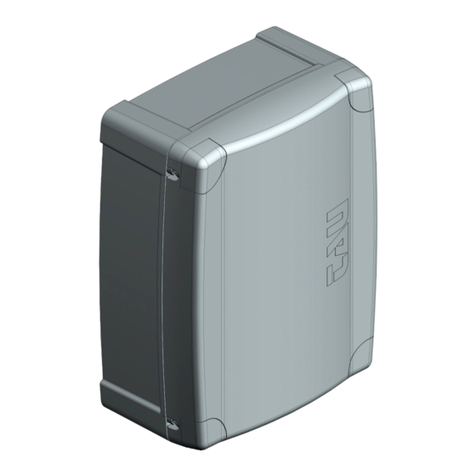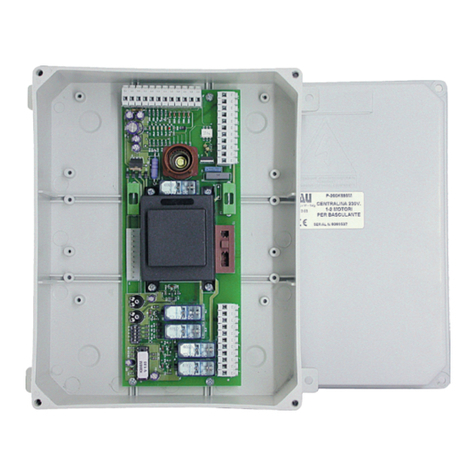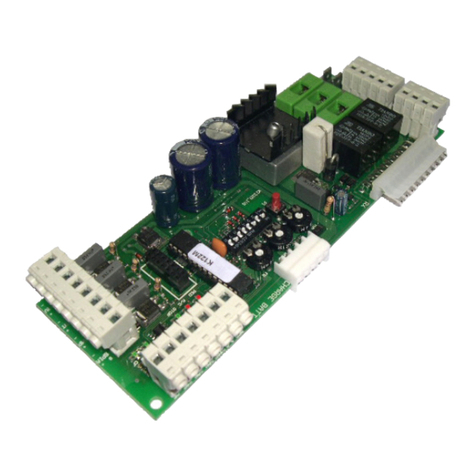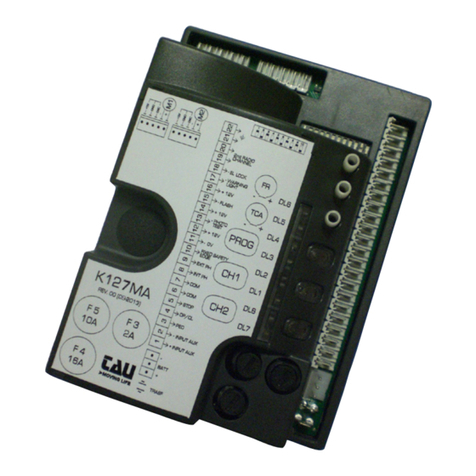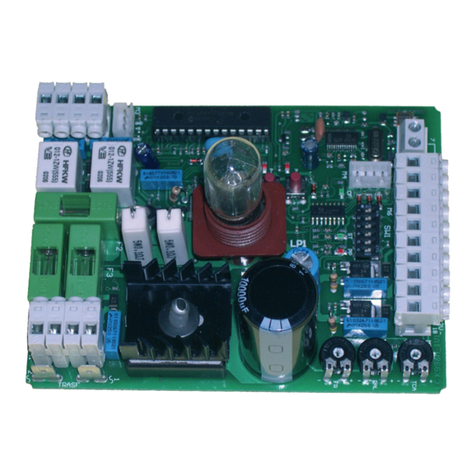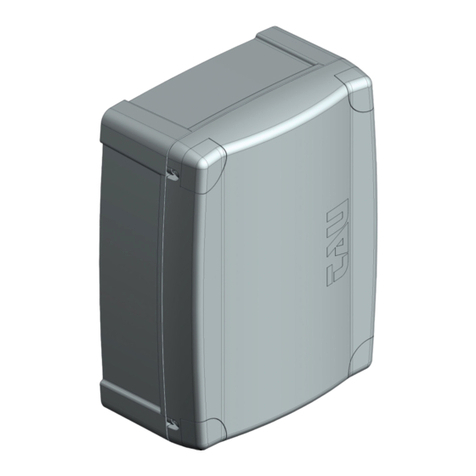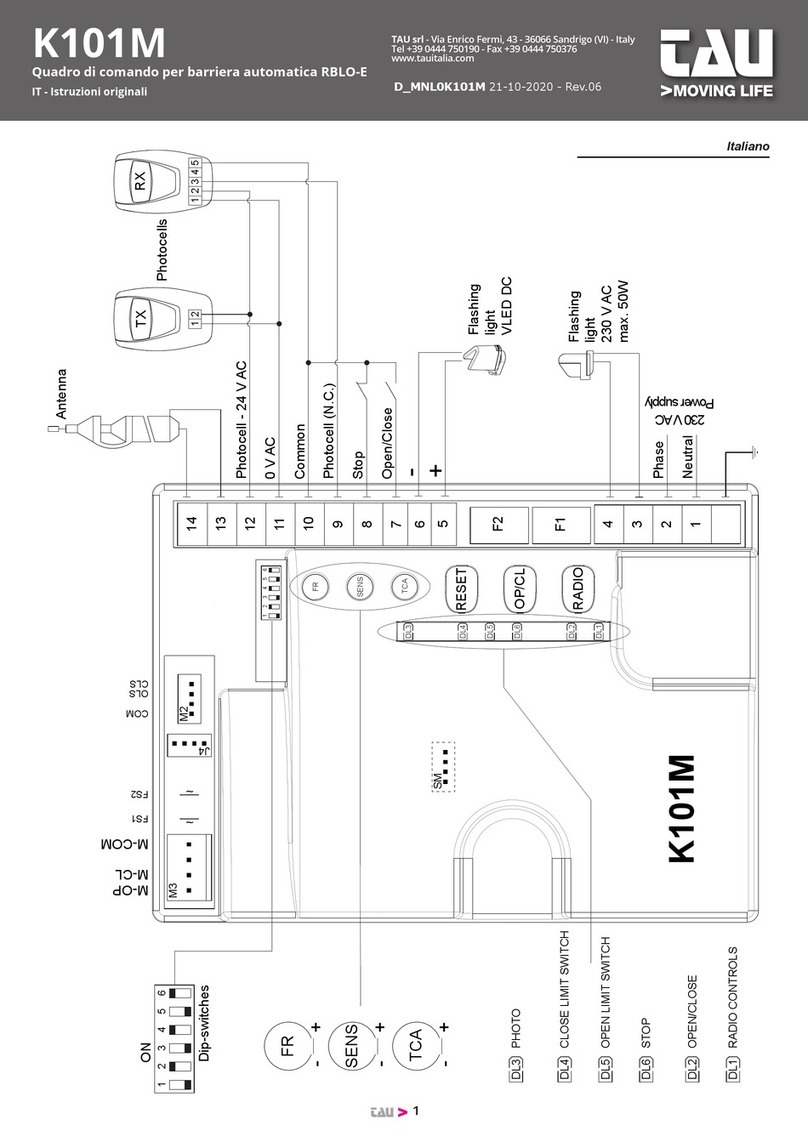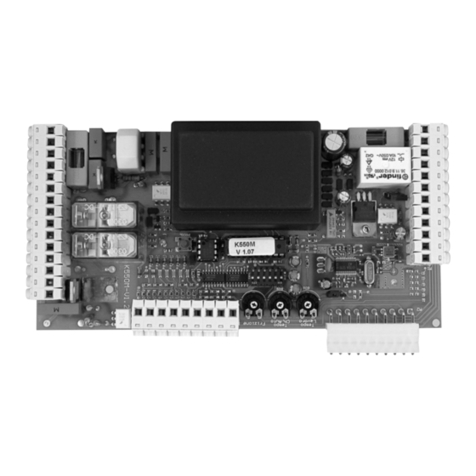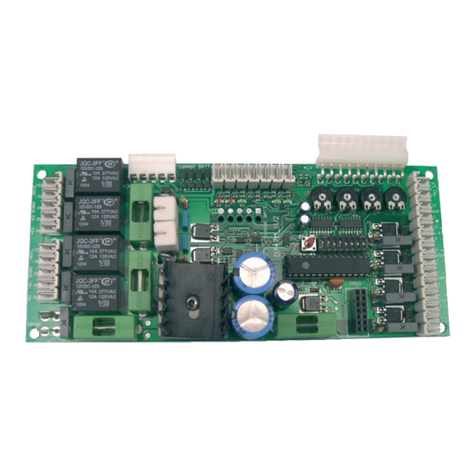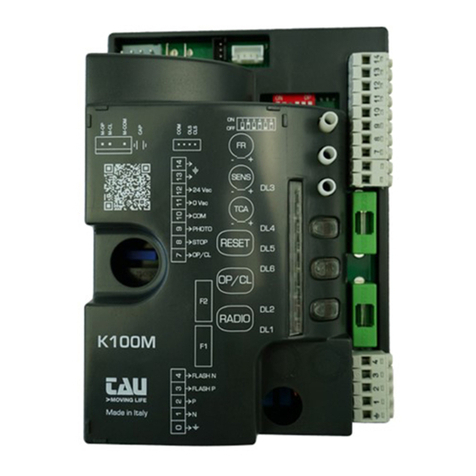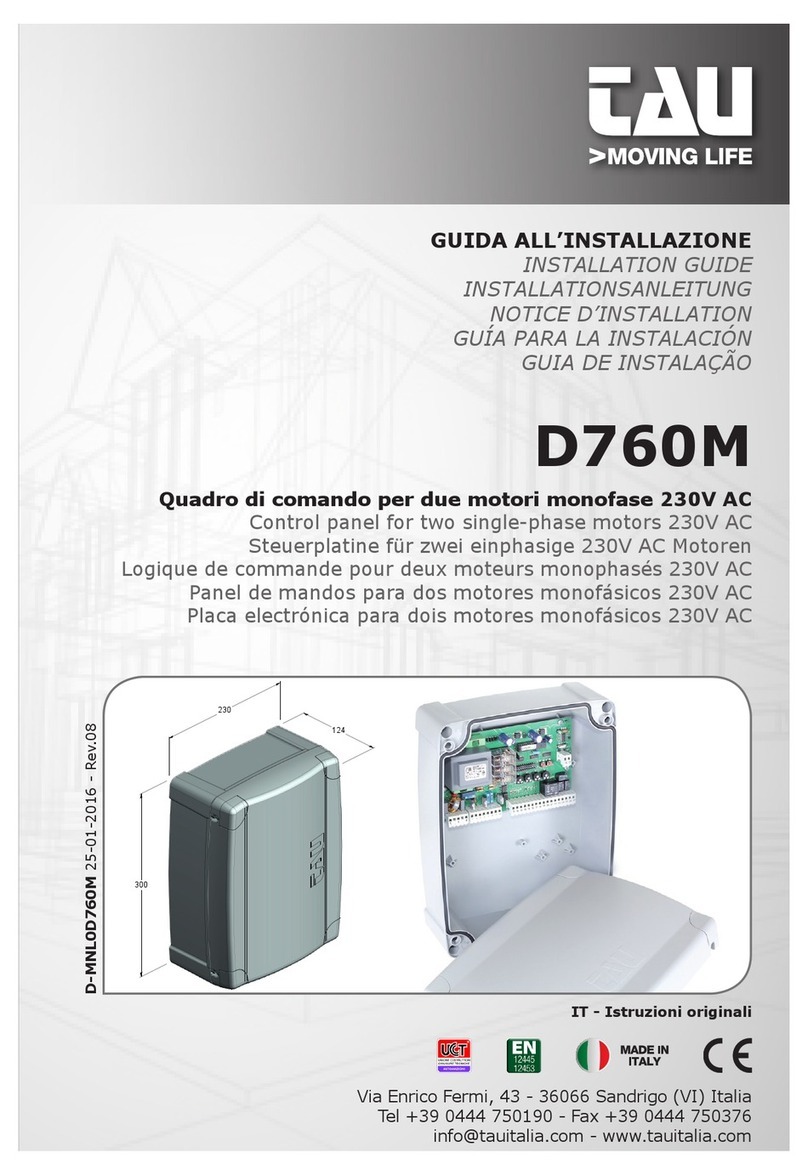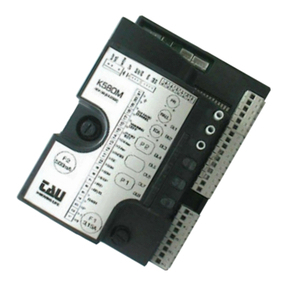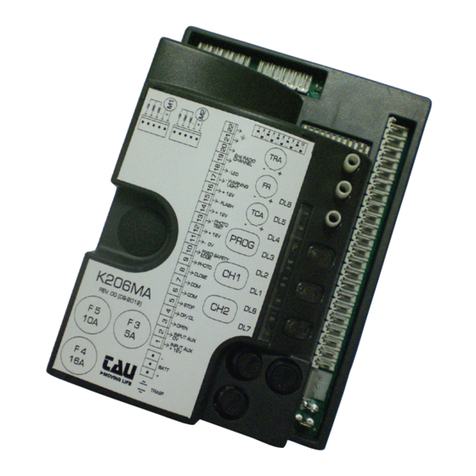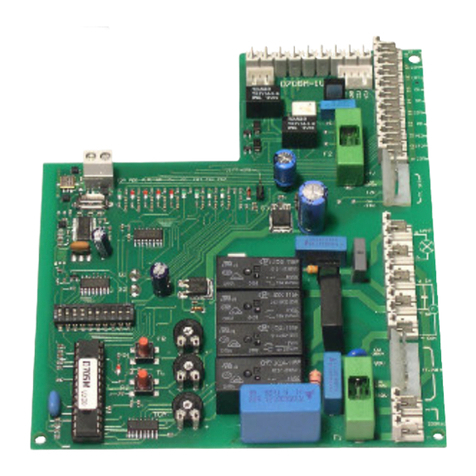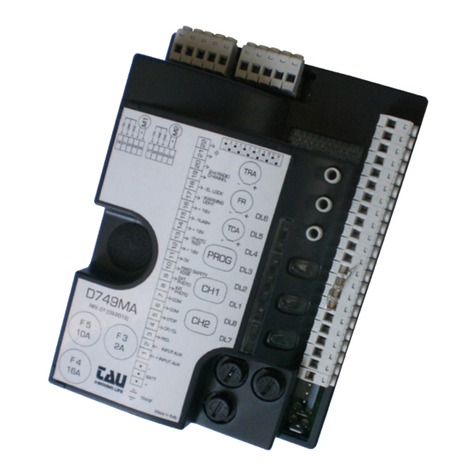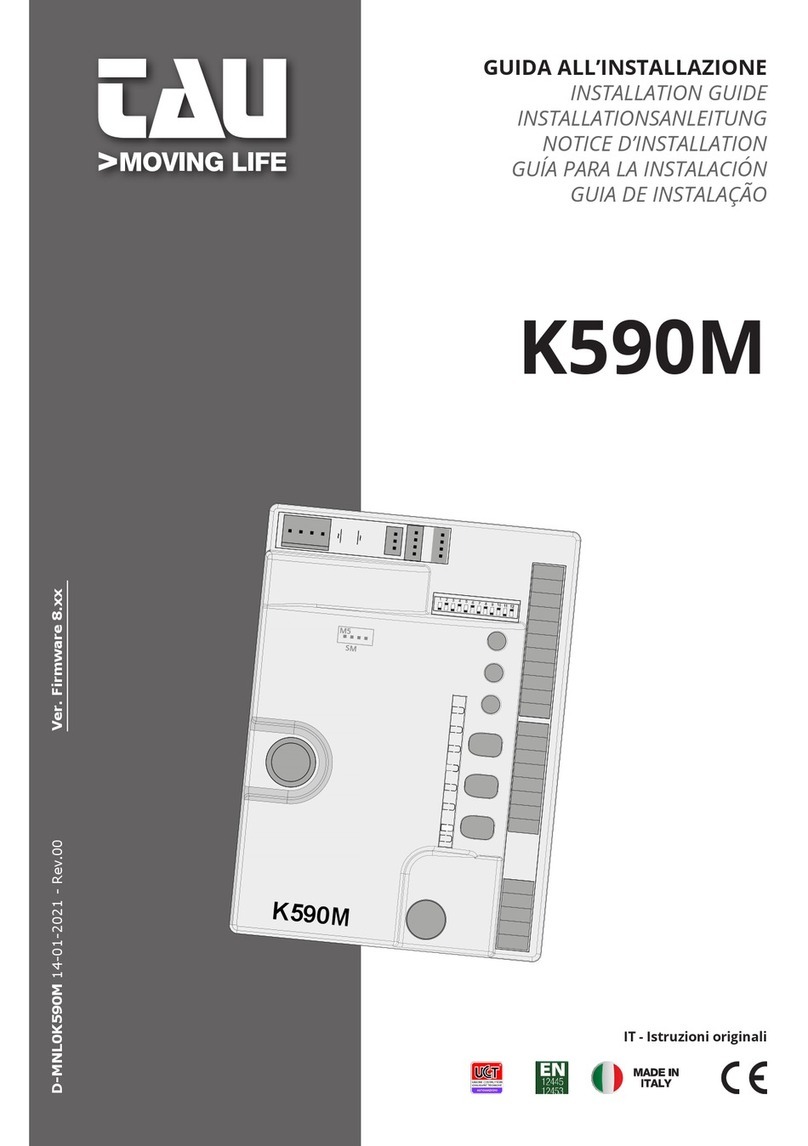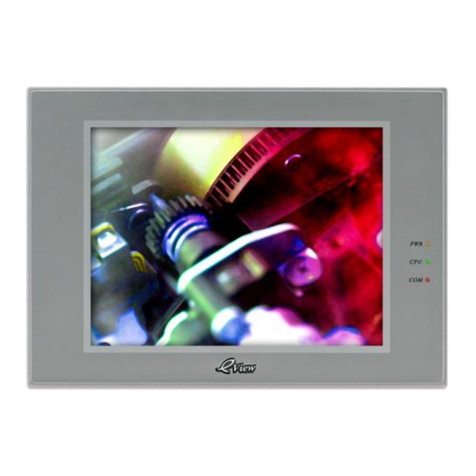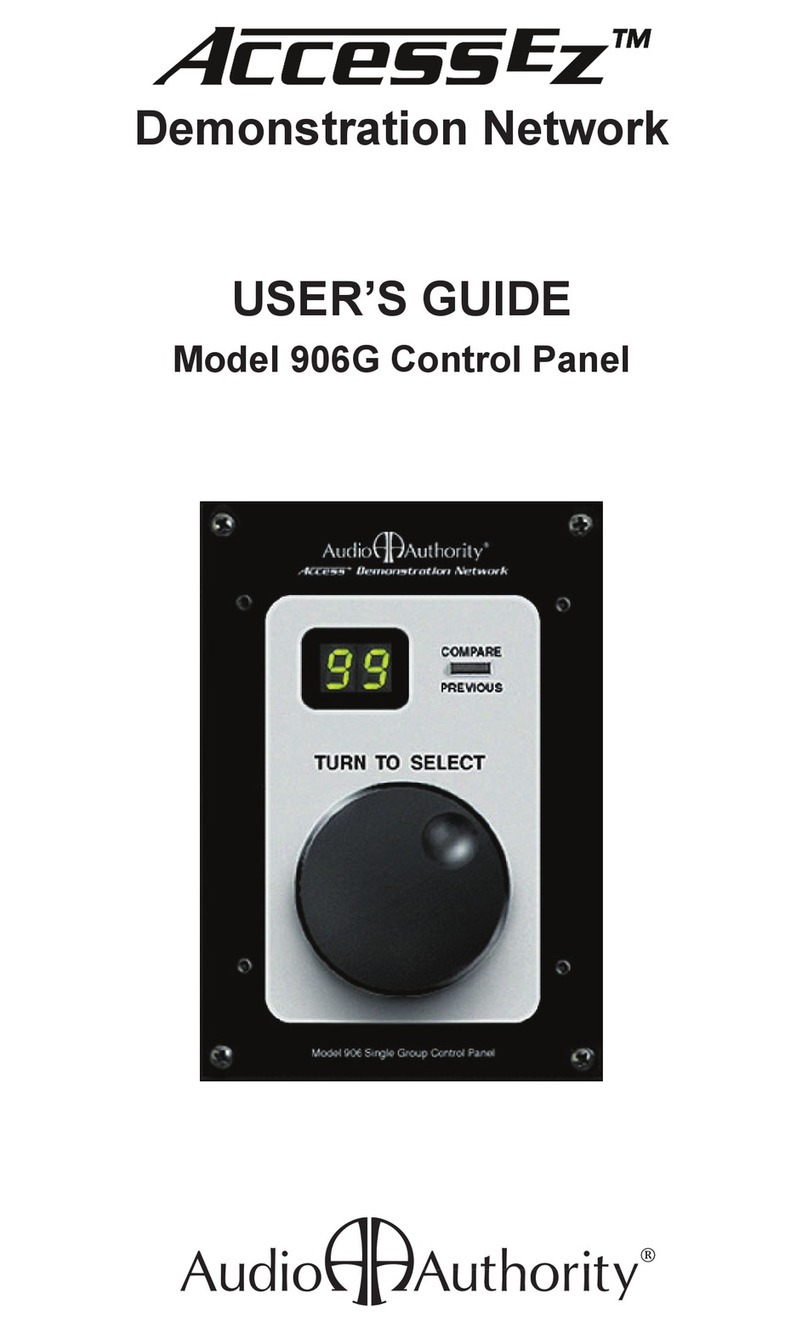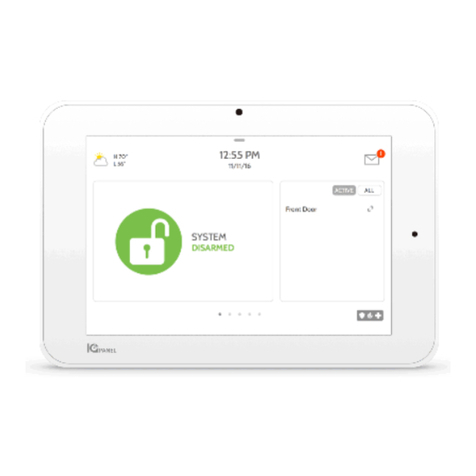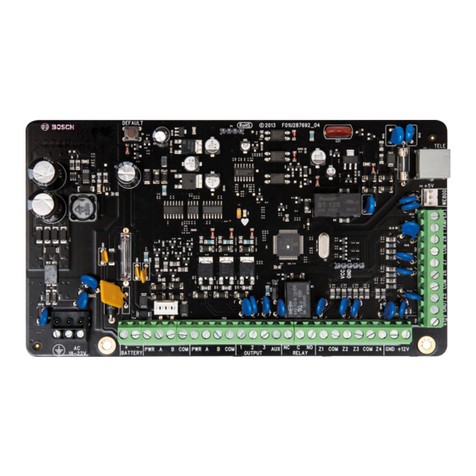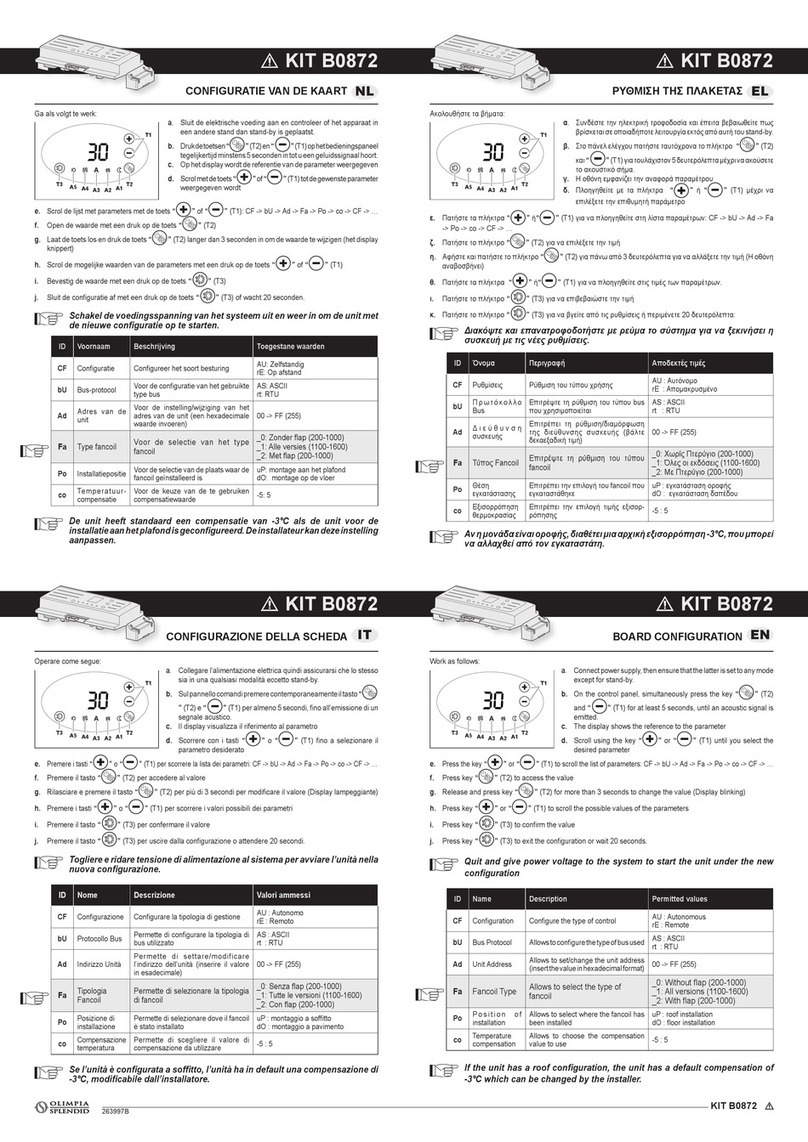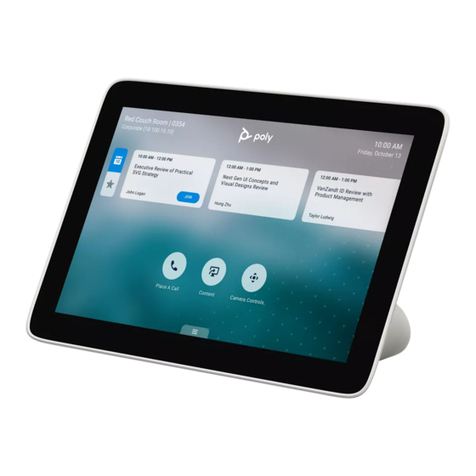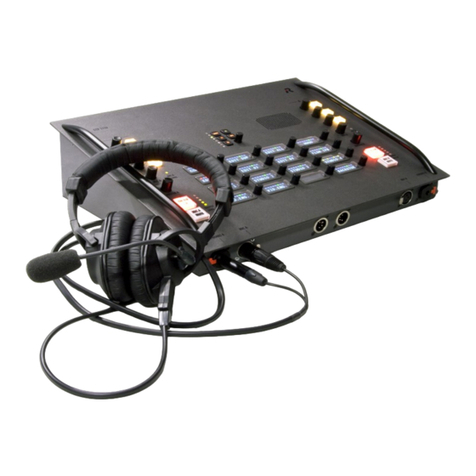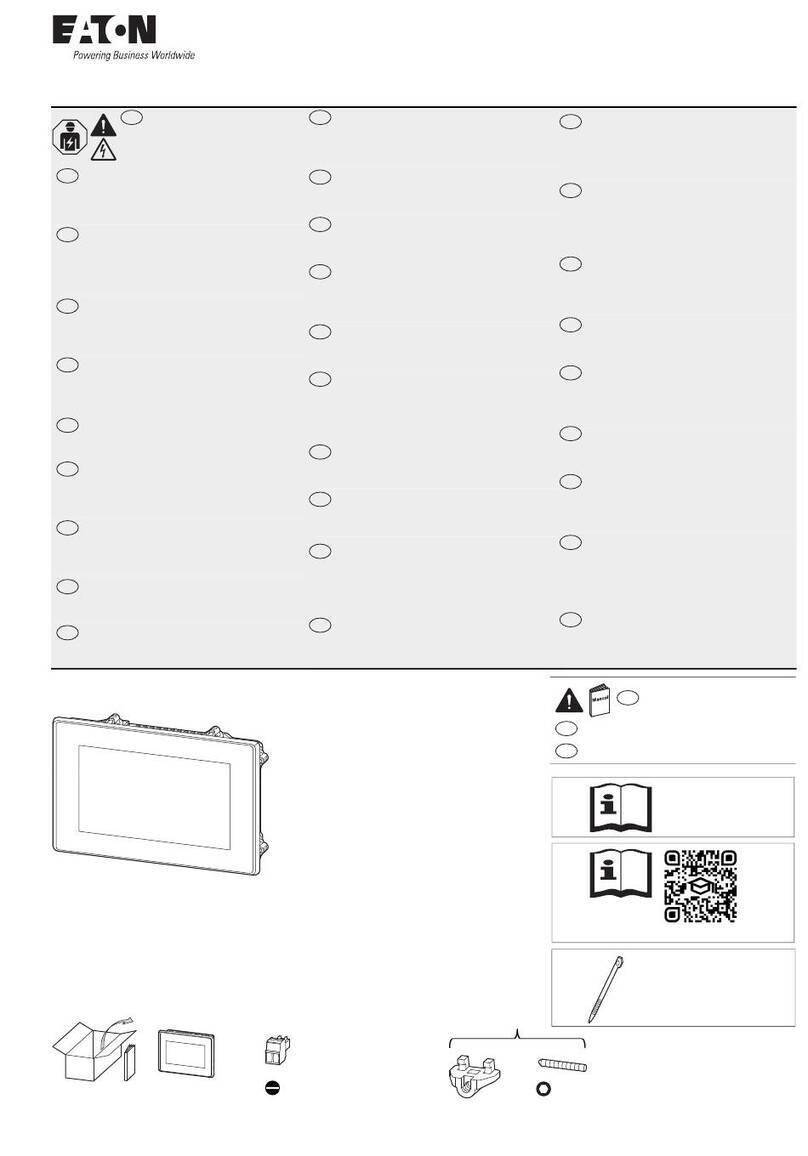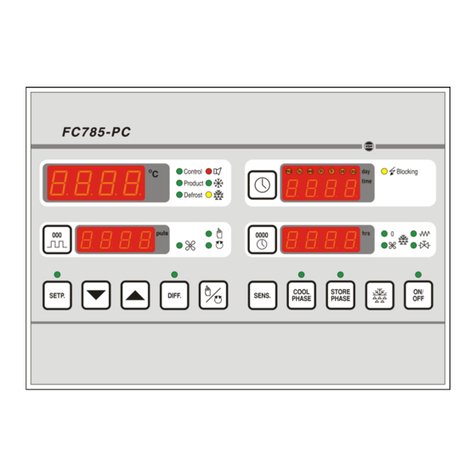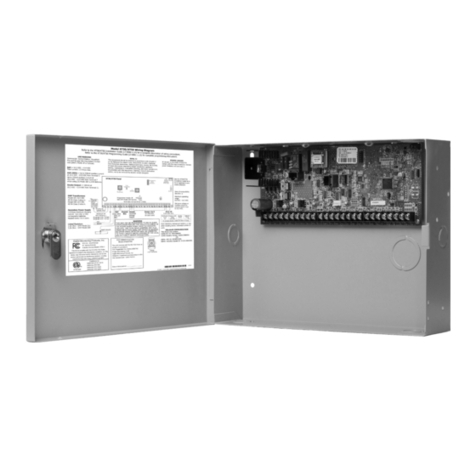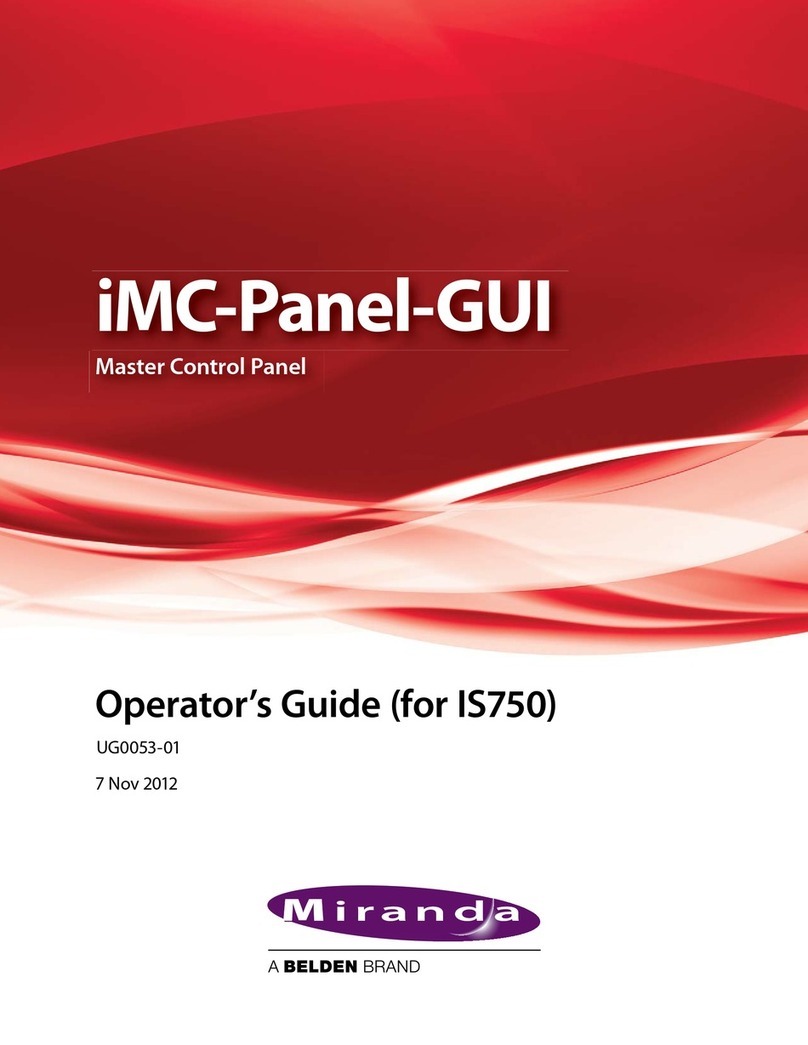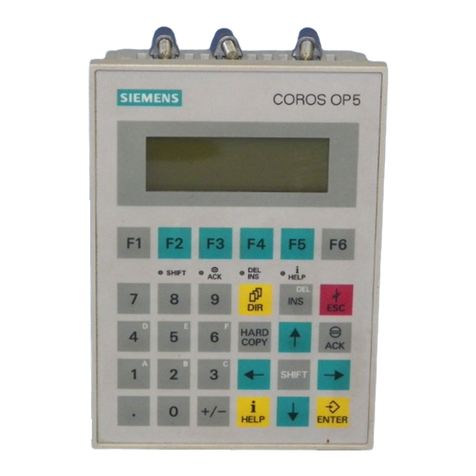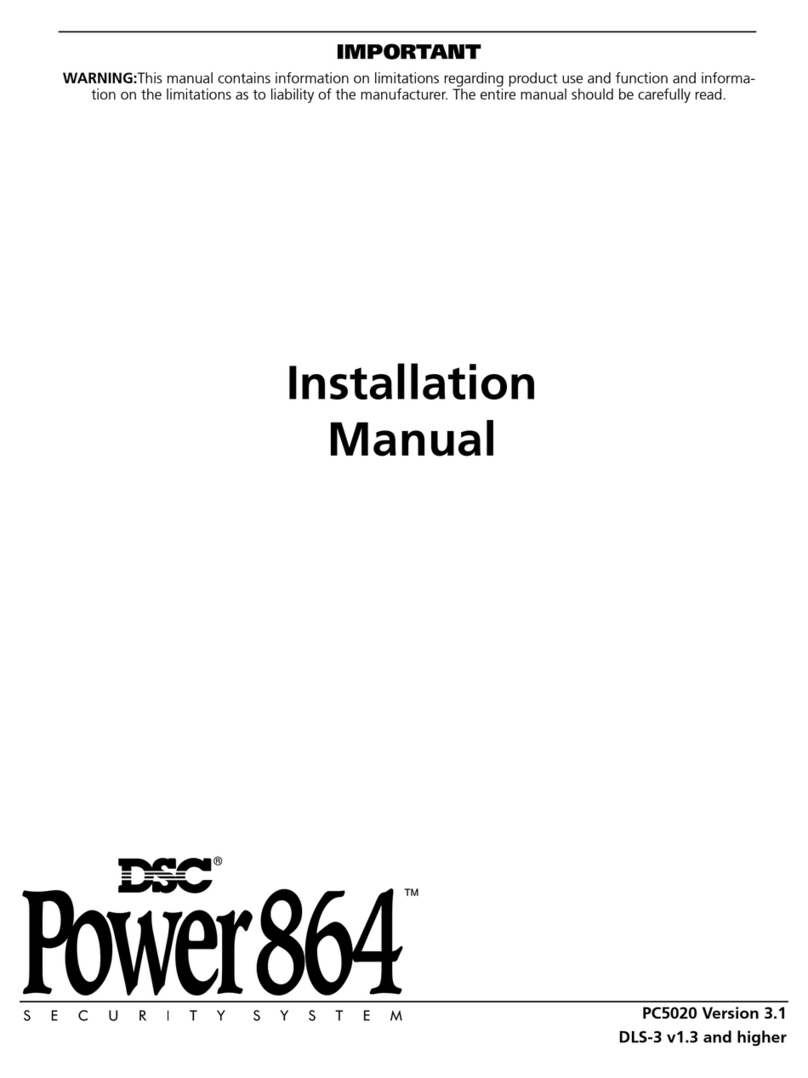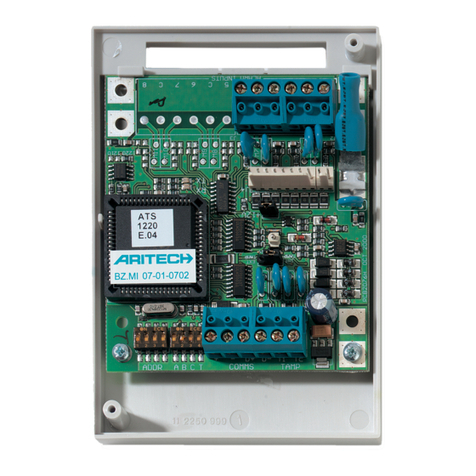tau K570M User manual

1
K570M
K570M
TAU srl via E. Fermi, 43 - 36066 Sandrigo (VI) Italia - Tel ++390444750190 - Fax ++390444750376 - E-mail: [email protected]
Edizione 02 - anno 2007 rev. 07 del 09/09/2008
http://www.tauitalia.com
SCHEDA DI COMANDO PER UN MOTORE 230 Vac
CONTROL PANEL FOR ONE 230 Vac MOTOR
STEUERSCHALTTAFEL FÜR EIEN 230 Vac MOTOR
ARMOIRE DE COMMANDE POUR UN MOTEUR 230 Vac
QUADRO DE MANDOS PARA UNO MOTOR 230 Vac
GUIDA ALL’INSTALLAZIONE
INSTALLATION GUIDE
INSTALLATIONSANLEITUNG
NOTICE D’INSTALLATION
GUÍA PARA LA INSTALACIÓN
>ITALIANO
>ENGLISH
>DEUTSCH
>FRANÇAIS
>ESPAÑOL

2
K570M
Introduzione
Il presente manuale è destinato solamente al personale tecnico qualifi cato per l’installazione.
Nessuna informazione contenuta nel presente fascicolo può essere considerata d’interesse per
l’utilizzatore finale. Questo manuale è allegato alla centralina K570M, non deve pertanto essere
utilizzato per prodotti diversi!
Avvertenze importanti:
Togliere l’alimentazione di rete alla scheda prima di accedervi.
La centralina K570M è destinata al comando di un motoriduttore elettromeccanico per
l’automazione di cancelli, porte e portoni.
Ogni altro uso è improprio e, quindi, vietato dalle normative vigenti.
È nostro dovere ricordare che l’automazione che state per eseguire, è classifi cata come
“costruzione di una macchina” e quindi ricade nel campo di applicazione della direttiva europea
89/392 CEE (Direttiva Macchine).
Questa, nei punti essenziali, prevede che:
- l’installazione deve essere eseguita solo da personale qualificato ed esperto;
- chi esegue l’installazione dovrà preventivamente eseguire “l’analisi dei rischi” della
macchina;
- l’installazione dovrà essere fatta a “regola d’arte”, applicando cioè le norme;
- infine dovrà essere rilasciata al proprietario della macchina la”dichiarazione di conformità”.
Risulta chiaro quindi che l’installazione ed eventuali interventi di manutenzione devono essere
effettuati solo da personale professionalmente qualificato, in conformità a quanto previsto dalle
leggi, norme o direttive vigenti.
Nella progettazione delle proprie apparecchiture, TAU rispetta le normative applicabili al prodotto
(vedere la dichiarazione di conformità allegata); è fondamentale che anche l’installatore, nel
realizzare gli impianti, prosegua nel rispetto scrupoloso delle norme.
Personale non qualificato o non a conoscenza delle normative applicabili alla categoria dei
“cancelli e porte automatiche” deve assolutamente astenersi dall’eseguire installazioni ed
impianti.
Chi non rispetta le normative è responsabile dei danni che l’impianto potrà causare!
Si consiglia di leggere attentamente tutte le istruzioni prima di procedere con l’installazione.
Italiano
Introduction
This manual has been especially written for use by qualifi ed fitters. No information given in
this manual can be considered as being of interest to end users. This manual is enclosed with
control unit K570M and may therefore not be used for different products!
Important information:
Disconnect the panel from the power supply before opening it.
The K570M control unit has been designed to control an electromechanical gear motor for
automating gates and doors of all kinds.
Any other use is considered improper and is consequently forbidden by current laws.
Please note that the automation system you are going to install is classifi ed as “machine
construction” and therefore is included in the application of European directive 89/392 EEC
(Machinery Directive).
This directive includes the following prescriptions:
- Only trained and qualified personnel should install the equipment;
- the installer must first make a “risk analysis” of the machine;
- the equipment must be installed in a correct and workmanlike manner in compliance with all
the standards concerned;
- after installation, the machine owner must be given the “declaration of conformity”.
This product may only be installed and serviced by qualified personnel in compliance with
English
D-MNL0K570M

3
K570M
current, laws, regulations and directives.
When designing its products, TAU observes all applicable standards (please see the attached
declaration of conformity) but it is of paramount importance that installers strictly observe the
same standards when installing the system.
Unqualified personnel or those who are unaware of the standards applicable to the “automatic
gates and doors” category may not install systems under any circumstances.
Whoever ignores such standards shall be held responsible for any damage caused by the
system!
Do not install the unit before you have read all the instructions.
Einleitung
Das vorliegende Handbuch ist nur für technisches, zur Installation qualifiziertes Personal
bestimmt.
Die im vorliegenden Heft enthaltenen Informationen sind für den Endbenutzer nicht
interessant.
Diese Anleitung liegt der Steuerung K570M bei und darf daher nicht für andere Produkte
verwendet werden!
Wichtige Hinweise:
Die Netzstromversorgung vor dem Zugriff zur Schalt- und Steuertafel abschalten.
Die Steuerung K570M dient zum Steuern eines elektromechanischen Getriebemotors für die
Automatisierung von Türen und Toren.
Jeder andere Einsatz ist unsachgemäß und daher laut gültiger Vorschriften verboten.
Unsere Pflicht ist, Sie daran zu erinnern, dass die Automatisierung, die Sie ausführen werden,
als „Maschinenkonstruktion“ klassiert ist und daher zum Anwendungsbereich der Europäischen
Richtlinie 89/392 (Maschinenrichtlinie) gehört.
Nach den wichtigsten Punkten dieser Vorschrift:
- darf die Installation ausschließlich von erfahrenem Fachpersonal ausgeführt werden;
- muss jener, der die Installation ausführt, vorher eine „Risikoanalyse“ der Maschine
machen;
- muss die Installation “fachgerecht” bzw. unter Anwendung der Vorschriften ausgeführt
sein;
- muss dem Besitzer der Maschine die „Konformitätserklärung” ausgehändigt werden.
Es ist daher offensichtlich, dass Installation und eventuelle Wartungseingriffe nur von beruflich
qualifiziertem Personal in Übereinstimmung mit den Verordnungen der gültigen Gesetze,
Normen und Vorschriften ausgeführt werden dürfen.
Bei der Planung ihrer Apparaturen hält sich TAU an die für das Produkt anwendbaren Vorschriften
(siehe anliegende Konformitätserklärung); von grundlegender Wichtigkeit ist, dass sich auch
der Installateur bei der Durchführung der Anlage genauestens an die Vorschriften hält.
Personal, das nicht qualifiziert ist oder die Vorschriften nicht kennt, die für die Kategorie
“automatische Türen und Tore” anwendbar sind, darf Installationen und Anlagen keinesfalls
ausführen.
Wer sich nicht an die Vorschriften hält, haftet für die Schäden, die von der Anlage verursacht
werden können.
Vor der Installation bitte alle Anweisungen genau lesen.
Deutsch
Introduction
Le présent manuel est destiné exclusivement au personnel technique qualifié pour
l’installation.
Aucune information contenue dans ce fascicule ne peut être considérée comme intéressante
pour l’utilisateur final. Ce manuel est joint à l’armoire de commande K570M, il ne doit donc pas
être utilisé pour des produits différents !
Recommandations importantes :
Couper l’alimentation électrique de l’armoire avant d’y accéder.
Français

4
K570M
Introducción
Este manual está destinado sólo al personal técnico cualificado para la instalación. Ninguna
información contenida en este manual puede ser considerada interesante para el usuario final.
Este manual acompaña a la central K570M; por lo tanto, ¡no debe utilizarse para otro tipo de
producto!
Advertencias importantes:
Corte la alimentación de red a la tarjeta antes de acceder a ella.
La central K570M está destinada al accionamiento de un motorreductor electromecánico para
la automatización de cancelas, puertas y portones.
Cualquier otro uso es considerado inadecuado y, por consiguiente, está prohibido por las
normativas vigentes.
Es nuestro deber recordarle que la automatización que está por realizar está clasificada como
«construcción de una máquina» y, por consiguiente, entra dentro del campo de aplicación de la
directiva europea 89/392 CEE (Directiva de máquinas).
Dicha normativa, en los puntos fundamentales, prevé que:
- la instalación debe ser efectuada sólo por personal cualificado y experto;
- la persona que efectúe la instalación deberá analizar preventivamente los riesgos de la
máquina;
- la instalación deberá ser hecha según las reglas del arte, es decir aplicando las normas;
- por último, habrá que expedir al dueño de la máquina la «declaración de conformidad».
Por consiguiente, es evidente que la instalación y los posibles trabajos de mantenimiento deben
ser efectuados por personal cualificado, de acuerdo con cuanto previsto por las leyes, normas
y directivas vigentes.
Durante el diseño de sus equipos, TAU respeta las normativas aplicables al producto (véase la
declaración de conformidad adjunta); también es fundamental que el instalador, al realizar la
instalación, respete escrupulosamente las normas.
Personal no cualificado, o que no conozca las normativas aplicables a la categoría de las
«cancelas y puertas automáticas», debe abstenerse de efectuar instalaciones.
¡Quien no respeta las normativas es responsable de los daños que la instalación podría
provocar!
Se aconseja leer con atención todas las instrucciones antes de proceder con la instalación.
Español
L’armoire de commande K570M est destinée à la commande d’un motoréducteur
électromécanique pour l’automatisation de portails et de portes.
Toute autre utilisation est impropre et donc interdite par les normes en vigueur.
Nous nous devons de rappeler que l’automatisation que vous vous apprêtez à exécuter est
classée comme “construction d’une machine” et rentre donc dans le domaine d’application de la
Directive Européenne 89/392 CEE (Directive Machines).
Cette directive, dans ses grandes lignes, prévoit que :
- l’installation doit être exécutée exclusivement par du personnel qualifié et expert ;
- qui effectue l’installation devra procéder au préalable à “l’analyse des risques” de la
machine;
- l’installation devra être faite dans les “règles de l’art”, c’est-à-dire en appliquant les normes;
- l’installateur devra remettre au propriétaire de la machine la ”déclaration de conformité”.
Il est donc clair que l’installation et les éventuelles interventions de maintenance doivent être
effectuées exclusivement par du personnel professionnellement qualifié, conformément aux
prescriptions des lois, normes ou directives en vigueur.
Dans le projet de ses appareils, TAU respecte les normes applicables au produit (voir la
déclaration de conformité jointe) ; il est fondamental que l’installateur lui aussi, lorsque qu’il
réalise l’installation, respecte scrupuleusement les normes.
Tout personnel non qualifié ou ne connaissant pas les normes applicables à la catégorie des
“portails et portes automatiques” doit absolument s’abstenir d’effectuer des installations.
Qui ne respecte pas les normes est responsable des dommages que l’installation pourra
causer!
Nous conseillons de lire attentivement toutes les instructions avant de procéder à l’installation.

5
K570M
INSTALLAZIONE
Prima di procedere assicurarsi del buon funzionamento della parte meccanica. Verificare inoltre che
il gruppo motoriduttore sia stato installato correttamente seguendo le relative istruzioni. Eseguiti
questi controlli, assicurarsi che il motoriduttore non abbia un assorbimento durante il movimento
superiore a 3 A (per un corretto funzionamento del quadro di comando).
L’INSTALLAZIONE DELL’APPARECCHIATURA DEVE ESSERE EFFETTUATA “A REGOLA D’ARTE” DA
PERSONALE QUALIFICATO COME DISPOSTO DALLA LEGGE 46/90.
NB : si ricorda l’obbligo di mettere a massa l’impianto nonché di rispettare le normative sulla sicurezza in
vigore in ciascun paese.
LA NON OSSERVANZA DELLE SOPRAELENCATE ISTRUZIONI PUÒ PREGIUDICARE IL BUON
FUNZIONAMENTO DELL’APPARECCHIATURA E CREARE PERICOLO PER LE PERSONE, PERTANTO
LA “CASA COSTRUTTRICE” DECLINA OGNI RESPONSABILITÀ PER EVENTUALI MAL FUNZIONAMENTI
E DANNI DOVUTI ALLA LORO INOSSERVANZA.
INSTALLATION
Before proceeding, make sure the mechanical components work correctly. Also check that the gear
motor assembly has been installed according to the instructions. Then make sure that the power
consumption of the gear motor is not greater than 3A (otherwise the control panel may not work
properly).
THE EQUIPMENT MUST BE INSTALLED “EXPERTLY” BY QUALIFIED PERSONNEL AS REQUIRED BY
LAW.
NB : it is compulsory to earth the system and to observe the safety regulations that are in force in each
country.
IF THESE ABOVE INSTRUCTIONS ARE NOT FOLLOWED IT COULD PREJUDICE THE PROPER
WORKING ORDER OF THE EQUIPMENT AND CREATE HAZARDOUS SITUATIONS FOR PEOPLE. FOR
THIS REASON THE “MANUFACTURER” DECLINES ALL RESPONSIBILITY FOR ANY MALFUNCTIONING
AND DAMAGES THUS RESULTING.
INSTALLATION
Bevor man weitermacht, den korrekten Betrieb des mechanischen Teils überprüfen und konrollieren,
ob der Getriebemotor richtig nach den jeweiligen Anweisungen installiert ist. Nachdem diese
Kontrollen ausgefürt sind, muss sichergestellt werden, dass der Getriebemotor nicht mehr als 3A
Stromaufnahme hat (für den korrekten Betrieb der Steuertafel).
DAS GERÄT MUSS GEMÄß GESETZ 46.90 FACHGERECHT VON QUALIFIZIERTEM PERSONAL
INSTALLIERT WERDEN.
N.B.: Bitte beachten Sie, dass die Erdung der Anlage und die Einhaltung der in jedem Land gültigen
Sicherheitsvorschriften Pflicht ist.
DAS NICHTEINHALTEN DER OBEN ANGEFÜHRTEN ANLEITUNGEN KANN DEN EINWANDFREIEN
BETRIEB DES GERÄTS BEEINTRÄCHTIGEN UND GEFAHREN FÜR PERSONEN HERVORRUFEN.
DER HERSTELLER HAFTET DAHER NICHT FÜR BETRIEBSSTÖRUNGEN UND SCHÄDEN, DIE AUF
DAS NICHTEINHALTEN DER ANLEITUNGEN ZURÜCKZUFÜHREN SIND.
INSTALLATION
Avant de procéder, s’assurer du bon fonctionnement de la partie mécanique. Vérifier en outre que le
groupe opérateur a été correctement installé en suivant les instructions correspondantes. Une fois
que ces contrôles ont été effectués, s’assurer que l’absorption de l’opérateur ne dépasse pas 3A
(pour un fonctionnement correct de l’armoire de commande).
L’INSTALLATION DE L’EQUIPEMENT DOIT ETRE REALISEE “SELON LES REGLES DE L’ART” PAR LE
PERSONNEL COMPETENT AYANT LES QUALITES REQUISES PAR LA LOI.
N.B.: nous rappelons l’obligation de mettre l’installation à la terre et de respecter les normes de sécurité en
vigueur dans le pays d’installation.
LA NON OBSERVATION DES INSTRUCTIONS POURRAIT COMPROMETTRE LE BON FONCTIONNEMENT
DE L’APPAREILLAGE ET CREER UN DANGER POUR LES PERSONNES, PAR CONSEQUENT LA
MAISON DECLINE TOUTE RESPONSABILITE POUR D’EVENTUELLES DETERIORATIONS DUES A
UNE UTILISATION NON APPROPRIEE OU NON CONFORME AU MODE D’EMPLOI.
INSTALACIÓN
Antes de continuar, asegúrese de que la parte mecánica funcione bien. También controle que el
grupo motorreductor esté instalado correctamente siguiendo las instrucciones respectivas. Una
vez concluidos los controles, verifique que l’absorción del motorreductor no supere 3A (para un
funcionamiento correcto del quadro de mandos).
LA INSTALACIÓN DEL EQUIPO DEBE SER HECHA CORRECTAMENTE POR PERSONAL QUE REÚNA
LOS REQUISITOS DISPUESTOS POR LA LEY 46/90.
N.B.: se recuerda que es obligatorio conectar a tierra el equipo y respetar las normas de seguridad vigentes
en cada país.
LA INOBSERVANCIA DE LAS INSTRUCCIONES ANTEDICHAS PUEDE PERJUDICAR EL
FUNCIONAMIENTO CORRECTO DEL EQUIPO Y CONSTITUIR UN PELIGRO PARA LAS PERSONAS;
EL “FABRICANTE” NO SE CONSIDERA RESPONSABLE POR POSIBLES PROBLEMAS DE
FUNCIONAMIENTO Y DAÑOS QUE DE ELLOS SE DERIVEN.

6
K570M

7
K570M
SCHEDA DI COMANDO PER UN MOTORE 230 Vac
LOGICA CON MICROPROCESSORE
STATO DEGLI INGRESSI VISUALIZZATO DA LEDs
PROTEZIONE INGRESSO LINEA CON FUSIBILE
FUNZIONE “INGRESSO PEDONALE”
CIRCUITO DI LAMPEGGIO INCORPORATO
INGRESSO PER TIMER SETTIMANALE
RADIO RICEVITORE 433,92 MHz INTEGRATO A 2 CANALI (CH)
TEMPO DI LAVORO FISSO A 120 sec.
RILEVAMENTO AUTOMATICA DELLA FREQUENZA DI ALIMENTAZIONE (50 o 60 Hz)
ATTENZIONE:
- non utilizzare cavi unifilari (a conduttore unico), es. quelli citofonici, al fine di evitare
interruzioni sulla linea e falsi contatti;
- non riutilizzare vecchi cavi preesistenti.
COLLAUDO
A collegamento ultimato:
I Leds verdi LS devono essere tutti accesi (corrispondono ciascuno ad un ingresso
Normalmente Chiuso). Si spengono solo quando sono interessati i comandi ai quali sono
associati.
I Leds rossi LS devono essere tutti spenti (corrispondono ciascuno ad un ingresso
Normalmente Aperto) si accendono solo quando sono interessati i comandi ai quali sono
associati.
CARATTERISTICHE TECNICHE
Alimentazione scheda 230 Vac - 50 Hz
Potenza nominale 400 W
Fusibile rapido protezione alimentazione ingresso 230 Vac (F1 - 5x20) F 3,15 A
Tensione circuiti alimentazione motore 230 Vac
Tensione alimentazione circuiti dispositivi ausiliari 24 Vac
Fusibile rapido protezione ausiliari 24 V ac (F2 - 5x20) F 500 mA
Temperatura di funzionamento -20 °C ÷ +70 °C
Grado di protezione del contenitore IP 44
LED DI DIAGNOSI
DL1 led verde di segnalazione FOTOCELLULA
DL2 led verde di segnalazione BORDO SENSIBILE
DL3 led verde di segnalazione FINECORSA IN CHIUSURA
DL4 led verde di segnalazione FINECORSA IN APERTURA
DL5 led verde di segnalazione pulsante STOP
DL6 led rosso di segnalazione pulsante PEDONALE
DL7 led rosso di segnalazione pulsante APRE/CHIUDE
DL8 led rosso di segnalazione programmazione RADIOCOMANDI
Italiano

8
K570M
COLLEGAMENTI ALLA MORSETTIERA
1 - 2 - 3 ingresso ALIMENTAZIONE 230 Vac 50Hz (115 Vac 60 Hz). 1= FASE 2= TERRA 3=
NEUTRO;
4 - 5 uscita LAMPEGGIANTE 230 Vac 50 W max. Il segnale fornito è già opportunamente
modulato per l’uso diretto. La frequenza di lampeggio è leggermente superiore in
fase di chiusura;
6 - 7 - 8 uscita MOTORE monofase 230 Vac comune= 6; fase chiusura= 7; fase apertura= 8;
collegare il condensatore tra i morsetti 7 e 8.
9 - 12 ingresso pulsante APRE/CHIUDE (contatto Normalmente Aperto);
10 - 12 ingresso pulsante PEDONALE (contatto Normalmente Aperto);
11 - 12 ingresso pulsante STOP (contatto Normalmente Chiuso);
13 - 15 ingresso FOTOCELLULE O DISPOSITIVI DI SICUREZZA (contatto Normalmente
Chiuso); il loro intervento, in fase di chiusura provoca l’arresto seguito dalla totale
riapertura del cancello, in fase di apertura provoca la fermata temporanea del
cancello fino a rimozione dell’ostacolo rilevato (se programmato dip switch nr. 3 in
ON), (13=Comune).
N.B. Il trasmettittore della fotocellula deve sempre essere alimentato dai morsetti nr
22 e nr 24, in quanto su di esso si effettua la verifica del sistema di sicurezza
(Fototest). Senza questo collegamento, la centralina non funziona. Per eliminare
la verifica del sistema di sicurezza, o quando non si usano le fotocellule, porre il
dip-switch nr 7 in OFF.
13 - 14 ingresso COSTA DI SICUREZZA FISSA (contatto Normalmente Chiuso);
Funziona solo durante la fase di apertura del cancello e provoca la fermata temporanea
del cancello e una parziale richiusura dello stesso per circa 20 cm. liberando così
l’eventuale ostacolo (13= Comune).
16 - 17 Ingresso antenna per RX 433,92 MHz incorporata; 16= MASSA 17= SEGNALE
18 - 19 uscita 2° CANALE RADIO da utilizzarsi per aprire/chiudere un altro cancello o per
comandare le luci del giardino.
20 - 21 uscita per SPIA CANCELLO APERTO 24 Vac - max. 3 W; durante l’apertura del
cancello la spia lampeggia lentamente, a cancello aperto resta accesa e durante la
chiusura lampeggia velocemente.
22 - 24 uscita 24 Vac 10 W per l’ALIMENTAZIONE DEL TX DELLE FOTOCELLULE max. nr.
1 trasmettitore fotocellule.
23 - 24 uscita 24 Vac 10 W per l’ALIMENTAZIONE DEL RX DELLE FOTOCELLULE,
RICEVITORI ESTERNI, etc; collegare max. n° 3 coppie di fotocellule;
25 - 26 ingresso FINE CORSA APERTURA (contatto Normalmente Chiuso); 25= Comune;
25 - 27 ingresso FINE CORSA CHIUSURA (contatto Normalmente Chiuso); 25= Comune;
REGOLAZIONI LOGICHE
TRIMMER
T.C.A. Regolazione tempo di richiusura automatica da 5 a 120 secondi.
RALL. regolazione tempo di rallentamento: da 0 a 15 sec. prima del finecorsa;

9
K570M
Nota: prima di impostare il rallentamento, l’automazione deve eseguire una
manovra completa di apertura e chiusura.
FR. Regolazione coppia motore. Regolare il trimmer per spinta del cancello atta a garantire
il funzionamento, facendo attenzione a non superare quella consentita dalle norme
in uso. Ruotando il trimmer in senso orario (+) si diminuisce la coppia motore,
viceversa, ruotandolo in senso antiorario (-), aumenta.
J 1 Con il ponticello aperto la spinta massima durante lo spunto non supera i 400Nm
ottemperando alle normative vigenti EN 12453. Con il ponticello chiuso la spinta
massima durante lo spunto è pari alle reali possibilità del motoriduttore ( condizione
da utilizzarsi per il mercato extra CEE).
Dip switch
1 on: ad apertura completata, la chiusura del cancello è automatica trascorso un tempo
impostato sul trimmer T.C.A.;
off: la chiusura necessita di un comando manuale;
2 on: ad automazione funzionante, una sequenza di comandi di apertura/chiusura induce
il cancello ad una APERTURA-CHIUSURA-APERTURA-CHIUSURA, etc. (vedi anche dip
switch 4);
off: nelle stesse condizioni, la stessa sequenza di comandi di apertura/chiusura induce il
cancello ad una APERTURA-STOP-CHIUSURA-STOP-APERTURA-STOP, etc. (funzione
passo-passo);
3 on: durante la fase di apertura la fotocellula interviene arrestando il cancello fino a rimozione
dell’ostacolo rilevato.
off: durante la fase di apertura la fotocellula non interviene.
4 on: l’inversione di marcia avviene solo in fase di chiusura.
off: azionando il pulsante apre-chiude avremo una inversione di marcia anche in fase di
apertura.
5 on: la funzione rallentamento è esclusa;
off: la funzione rallentamento è inserita e può essere regolata agendo sul trimmer RALL.;
6 on: la funzione prelampeggio è abilitata.
off: la funzione prelampeggio è disabilitata.
7 on: la funzione “verifica delle fotocellule” è inserita;
off: la funzione “verifica delle fotocellule” è disinserita. N.B.: da utilizzare quando non si
usano le fotocellule;
8 on: la funzione monostabile del relè di comando CH2 (morsetti nr 18 e 19) è inserita;
off: la funzione bistabile (o PASSO-PASSO) del relè di comando CH2 (morsetti nr 18 e 19)
è inserita;
9 on: con il dip-switch 8 in ON (funzione monostabile) il contatto N.A. rimane chiuso per 180
sec. (tempo fisso non variabile per il comando temporizzato delle luci);
off: con il dip-switch 8 in ON (funzione monostabile) il contatto N.A. rimane chiuso per 2 sec.
(tempo fisso non variabile per il comando di una seconda automazione).
10 on: funzionamento per anta con apertura verso destra;
off: funzionamento per anta con apertura verso sinistra;
Funzione orologio:
È possibile utilizzare un timer (esempio settimanale) collegato all’ingresso del pulsante apre-
chiude per mantenere aperto il cancello in determinate fascie orarie e permetterne poi la
richiusura automaitca
RADIO RICEVITORE 433,92 MHz INTEGRATO
Il radio ricevitore può apprendere fino ad un max di 8 codici a dip-switches (TXD2, TXD4, BUG2,
BUG4) o rolling code (BUG2R, BUG4R) da impostare liberamente su due canali.
Il primo canale comanda direttamente la scheda di comando per l’apertura dell’automazione; il
secondo canale comanda un relè per un contatto pulito N.A. in uscita (morsetti nr 18 e 19, max
24 Vac, 1 A).
La modalità di apprendimento (dip-switches o rolling code) viene determinata dal primo
radiocomando e rimarrà la stessa fino alla cancellazione totale di tutti i codici.
APPRENDIMENTO RADIOCOMANDI
P1 = APRE/CHIUDE
P2 = 2° canale
1_ premere brevemente il tasto P1 se si desidera associare un radiocomando alla funzione
APRE/CHIUDE;

10
K570M
2_ il led DL8 si spegne per indicare la modalità di apprendimento dei codici (se non viene immesso
nessun codice entro 10 secondi, la scheda esce dalla modalità di programmazione);
3_ premere il tasto del radiocomando che si desidera utilizzare;
4_ il led DL8 si riaccende per segnalare l’avvenuta memorizzazione (se ciò non accade,
attendere 10 secondi e riprendere dal punto 1);
5_ se si desidera memorizzare altri radiocomandi, ripetere la procedura dal punto 1 fino ad un
massimo di 8 trasmettitori;
6_ se si desidera effettuare la memorizzazione sul 2° canale, ripetere la procedura dal punto 1
utilizzando il tasto P2 anzichè il tasto P1;
7_ se si desidera uscire dalla modalità di apprendimento senza memorizzare un codice, premere
brvemente il tasto P1 o il tasto P2.
N.B.: nel caso di superamento del nr massimo di radiocomandi (nr 8), il led DL8
inizierà a lampeggiare velocemente per circa 3 secondi senza però eseguire la
memorizzazione.
PROGRAMMAZIONE REMOTA TRAMITE SLIM-R
Con la nuova versione di software V 2.xx è possibile eseguire l’apprendimento remoto della nuova
versione di radiocomandi SLIM-R, ossia senza agire direttamente sul tasto di programmazione
della ricevente.
Sarà sufficiente disporre di un radiocomando già programmato nella ricevente per poter aprire la
procedura di programmazione remota dei nuovi radiocomandi, programmati tramite TAUPROG.
Seguire la procedura riportata sulle istruzioni del radiocomando SLIM-R.
CANCELLAZIONE RADIOCOMANDI
1_ tenere premuto per 3 secondi ca. il tasto P1 al fine di cancellare tutti i radiocomandi ad esso
associati;
2_ il led DL8 inizia a lampeggiare lentamente per indicare che la modalità di cancellazione è
attivata;
3_ tenere premuto nuovamente il tasto P1 per 3 secondi;
4_ il led DL8 si spegne per 3 secondi ca. per poi riaccendersi fisso ad indicare l’avvenuta
cancellazione;
5_ riprendere la procedura dal punto 1 utilizzando il tasto P2 per cancellare tutti i radiocomandi
ad esso associati;
6_ se si desidera uscire dalla modalità di cancellazione senza memorizzare un codice, premere
brevemente il tasto P1 o il tasto P2.
ATTENZIONE: Se si desidera memorizzare un nuovo tipo di telecomando (es: da dip-
switches a rolling code o viceversa) è necessario cancellare entrambi i canali.
MALFUNZIONAMENTI: POSSIBILI CAUSE E RIMEDI
1_ L’automazione non parte
a_ Verificare con lo strumento (Multimetro) la presenza dell’alimentazione 230Vac;
b_ Verificare che i contatti N.C. della scheda siano effettivamente normalmente chiusi (5 led
verdi accesi);
c_ Impostare il dip 7 (fototest) su OFF;
d_ Controllare con lo strumento (Multimetro) che i fusibili siano integri.
2_ Il radiocomando ha poca portata
a_ Collegare l’antenna radio sui morsetti presenti sulla scheda ricevente e non sui morsetti
16-17 della scheda di comando;
b_ Controllare che il collegamento della massa e del segnale dell’antenna non sia inverti-
to;
c_ Non eseguire giunzioni per allungare il cavo dell’antenna;
d_ Non installare l’antenna in posizioni basse o in posizioni nascoste dalla muratura o dal
pilastro;
e_ Controllare lo stato delle pile del radiocomando.
3_ Il cancello si apre al contrario
a_ Invertire la posizione del dip-switch nr. 10, dopo aver tolto l’alimentazione al qua-
dro di comando.

11
K570M
CONTROL PANEL FOR ONE 230 Vac MOTOR
MICROPROCESSOR-CONTROLLED LOGIC
INPUT STATUS LED’S
LINE INPUT FUSE
“PEDESTRIAN ENTRY” FUNCTION
BUILT-IN FLASHING LIGHT CIRCUIT
WEEKLY TIMER INPUT
433.92 MHz 2 CHANNEL BUILT-IN RADIO RECEIVER (CH)
OPERATING TIME FIXED AT 120 sec.
AUTOMATIC DETECTION OF THE FEEDING FREQUENCY (50 or 60 Hz)
ATTENTION:
- do not use single cables (with one single wire), ex. telephone cables, in order to avoid
breakdowns of the line and false contacts;
- do not re-use old pre-existing cables.
TESTING
When you have completed the connection:
All the green LS LEDs must be on (each of them corresponds to a Normally Closed input).
The go off only when the controls to which they are associated are operated.
All the red LS LEDs must be off (each of them corresponds to a Normally Open input). The
light up only when the controls to which they are associated are operated.
TECHNICAL CHARACTERISTICS
Power input to board 230 Vac - 50 Hz
Nominal power 400 W
Fast acting fuse for protection of input power supply 230 Vac (F1 - 5x20) F 3,15 A
Input voltage of motor circuits 230 Vac
Input voltage of auxiliary circuits 24 Vac
Fast acting fuse for protection of auxiliary circuits 24 V dc (F2 - 5x20) F 500 mA
Working temperature -20°C ÷ +70°C
Box protected to IP 44
DIAGNOSTICS LED
DL1 PHOTOCELL green LED signal
DL2 SENSITIVE EDGE green LED signal
DL3 CLOSE LIMIT SWITCH green LED signal
DL4 OPEN LIMIT SWITCH green LED signal
DL5 STOP button green LED signal
DL6 PEDESTRIAN button red LED signal
DL7 OPEN/CLOSE button red LED signal
DL8 RADIO CONTROLS programming red led
English

12
K570M
TERMINAL BOARD CONNECTIONS
1 - 2 - 3 POWER input 230 Vac 50Hz (115 Vac 60 Hz). 1= PHASE 2= EARTH 3= NEUTRAL
4 - 5 FLASHING LIGHT output 230 Vac 50 W max. The signal is already modulated for
direct use. Flashing frequency increases slightly during closing
6 - 7 - 8 MOTOR output single-phase 230 Vac common= 6; closing= 7; opening= 8; connect
the capacitor between terminals 7 and 8.
9 - 12 OPEN/CLOSE pushbutton input (Normally Open contact);
10 - 12 PEDESTRIAN pushbutton input (Normally Open contact);
11 - 12 STOP pushbutton input (Normally Closed contact);
13 - 15 PHOTOCELL OR SAFETY DEVICES input (Normally Closed contact); They stop
the gate during closing and totally reopen it; they temporarily stop the gate during
opening in order to allow the obstacle to be removed (if dip switch n° 3 set to ON),
(13= Common).
N.B. The photocell transmitter must always be supplied by terminals no. 22 and no.
24, since the safety system test (phototest) is carried out on it. Without this
connection, the control unit does not work. To override the testing of the safety
system, or when the photocells are not used, set dip-switch no. 7 to OFF.
13 - 14 FIXED SAFETY EDGE input (Normally Closed contact);
Works only when the gate is opening; temporarily stops the gate and partially closes
it by about 20 cm in order to allow the obstacle to be removed. (13=Common).
16 - 17 433,92 MHz built-in RX aerial input; 16= EARTH 17= SIGNAL
18 - 19 2nd RADIO CHANNEL output used for opening/closing another gate or controlling
garden illumination.
20 - 21 GATE OPEN LED output 24 Vac - max. 3 W; the LED flashes slowly during opening,
remains on when the gate is open and flashes rapidly during closing.
22 - 24 24 Vac 10 W POWER output for PHOTOCELL TX max. no. 1 photocell transmitter.
23 - 24 24 Vac 10 W POWER output for PHOTOCELL RX, EXTERNAL RECEIVERS, etc.
connect a max. of 3 pair of photocells;
25 - 26 OPEN LIMIT SWITCH input (Normally Closed contact); 25= Common.
25 - 27 CLOSE LIMIT SWITCH input (Normally Closed contact); 25= Common.
LOGIC ADJUSTMENTS
TRIMMER
T.C.A. Automatic closing time adjustment from 5 to 120 seconds.
RALL. Deceleration time adjustment: from 0 to 15 sec. before the limit switch;
Note: the automation must perform a complete opening and closing manoeuvre
before setting the deceleration.

13
K570M
FR. Motor torque adjustment. The trimmer is set to provide sufficient thrust to work the gate
without exceeding the limits established by current standards. Turn the TRIMMER
clockwise (+) to decrease the motor torque adjustments; turn it anticlockwise
(-) to increase.
J 1 When the jumper is open, maximum starting thrust does not exceed 400Nm, in
compliance with EN 12453. When the jumper is closed, maximum starting thrust
equals the true capacity of the gear motor (used for non-EEC markets).
Dip switch
1 on: after opening, the gate automatically closes when the delay set on the T.C.A. trimmer
expires.
off: automatic closing disabled.
2 on: with automatic closing enabled, a sequence of open/close commands causes the gate
to OPENCLOSE-OPEN-CLOSE etc (see also dip switch 4).
off: in the same conditions, the same command sequence causes the gate to OPEN-STOP-
CLOSESTOP-OPEN-STOP (step-by-step).
3 on: during opening, the photocell cuts in to stop the gate until the obstacle is removed.
off: during opening, the photocell does not cut in.
4 on: the direction of movement is only changed during closing.
off: the open-close pushbutton reverses the direction of movement of the gate even while it
is opening.
5 on: the deceleration function is off;
off: the deceleration function is on and can be adjusted by means of the RALL trimmer;
6 on: the pre-flashing function enabled.
off: the pre-flashing function disabled.
7 on: the “photocell test” function is enabled;
off: the “photocell test” function is disabled. N.B.: to be used when the photocells are not
used;
8 on: monostable function of the CH2 control relay (terminals 18 and 19) enabled;
off: bistable (or STEP-BY-STEP) function of the CH2 control relay (terminals 18 and 19)
enabled;
9 on: with dip-switch 8 ON (monostable function), the N.O. contact remains closed for 180
secs. (fixed invariable delay for the timed control of the lights);
off: with dip-switch 8 ON (monostable function), the N.O. contact remains closed for 2 secs.
(fixed invariable delay for commanding a second automatic system).
10 on: right-hand leaf opening function;
off: left-hand leaf opening function;
Clock function:
A timer can be connected to the open-close pushbutton in order to keep the gate open at certain
times during the day, after which it reverts to automatic closing.
433.92 MHz BUILT-IN RADIO RECEIVER
The radio receiver can learn up to a maximum of 8 dip-switches (TXD2, TXD4, BUG2, BUG4) or
rolling codes (BUG2R, BUG4R) which can be set on the two channels as required.
The first channel directly commands the control board for opening the automatic device; the
second channel commands a relay for a N.O. no-voltage output contact (terminals 18 and 19,
max. 24 Vac, 1 A).
The learning mode (dip-switch or rolling code) is determined by the first radio control device and
remains unchanged until all the codes have been cancelled.

14
K570M
LEARNING SYSTEM FOR RADIO CONTROL DEVICES
P1 = OPEN/CLOSE
P2 = 2nd channel
1_ press button P1 briefly to associate a radio control device with the OPEN/CLOSE function;
2_ LED DL8 turns off to indicate that the code learning mode has been activated (if no code is
entered within 10 seconds, the board exits the programming mode);
3_ press the button of the relative radio control device;
4_ LED DL8 turns on again to indicate that the code has been memorised (if this does not
happen, wait 10 seconds and start again from point 1);
5_ to memorise codes to other radio control devices, repeat the procedure from point 1 up to a
maximum of 8 transmitters;
6_ to memorise codes on the 2nd channel, repeat the procedure from point 1 using button P2
instead of P1;
7_ to exit the learning mode without memorising a code, press button P1 or P2 briefly.
N.B.: if the maximum number of radio control devices (8) is exceeded, LED DL8 flashes
rapidly for about 3 seconds without memorising the code.
REMOTE PROGRAMMING BY MEANS OF SLIM-R
With the new version of software V 2.xx it is possible to carry out the remote self-learning of
the new version of transmitters SLIM-R, that is without pressing the receiver’s programming
button.
It will be sufficient to have an already programmed transmitter in the receiver in order to start the
procedure of remote programming of the new transmitters, programmed by means of TAUPROG.
Follow the procedure written on the instructions of the transmitter SLIM-R.
CANCELLING CODES FROM RADIO CONTROL DEVICES
1_ keep button P1 pressed for 3 seconds in order to cancel all the associated radio control
devices;
2_ LED DL8 flashes slowly to indicate that the cancellation mode has been activated;
3_ press button P1 again for 3 seconds;
4_ LED DL8 turns off for approx. 3 seconds and then remains steady to indicate that the code
has been cancelled;
5_ repeat the procedure from point 1 using button P2 to cancel all the associated radio control
devices;
6_ to exit the learning mode without memorising a code, press button P1 or P2 briefly.
ATTENTION: TO memorise a code on a new type of remote control unit (e.g.: from dip-
switch to rolling code or vice-versa) both channels must be cancelled.
MALFUNCTIONS: POSSIBLE CAUSES AND SOLUTION
1- The automation does not start
a- Check there is 230Vac power supply with the multimeter;
b- Check that the NC contacts of the card are actually normally closed;
c- Set dip 7 (phototest) to OFF;
d- Check that the fuses are intact with the multimeter.
2- The radio control has very little range
a- Connect the radio aerial to the terminals of the receiver card and not to terminals 16-17
of the control card;
b- Check that the ground and the aerial signal connections have not been inverted;
c- Do not make joints to increase the length of the aerial wire;
d- Do not install the aerial in a low position or behind walls or pillars;
e- Check the state of the radio control batteries.
3- The gate opens the wrong way
a_ Invert the position of dip-switch No. 10 after having turned off the power to the
control unit.

15
K570M
STEUERSCHALTTAFEL FÜR EIEN 230 Vac MOTOR
MIKROPROZESSORLOGIK
STATUSANZEIGE DER EINGÄNGE DURCH LEDs
SCHUTZ DES LINIENEINGANGS MIT SICHERUNG
“GEHFLÜGEL”-FUNKTION
EINGEBAUTER BLINKKREISLAUF
EINGANG FÜR WOCHENTIMER
433,92 MHz FUNKEMPFÄNGER, EINGEBAUT, 2 KANÄLE (CH)
ARBEITSZEIT FIX 120 SEK.
AUTOMATISCHE ERKENNUNG DER VERSORGUNGSFREQUENZ (50 oder 60 Hz)
ACHTUNG:
- Verwenden Sie keine Leitungen mit einzeldraht wie z.b. bei den Sprechanlagen, um
unterbrechungen auf der Linie und zu vermeiden;
- Verwenden Sie keine alte vorhandene verkabelung.
ENDPRÜFUNG
Nach Beendigung der Anschlüsse:
müssen alle grünen LEDs LS leuchten (jede LED entspricht einem gewöhnlich geschlossenen
Eingang). Sie schalten erst ab, wenn die Steuervorrichtungen aktiviert sind, mit denen sie
kombiniert sind.
müssen alle roten LEDs LS abgeschaltet sein (jede LED entspricht einem gewöhnlich
geöffneten Eingang). Sie leuchten erst auf, wenn die Steuervorrichtungen aktiviert sind, mit
denen sie kombiniert sind.
TECHNISCHE MERKMALE
Versorgung der Schalt- und Steuertafel 230 Vac - 50 Hz
Höchstleistung 400 W
Schnellsicherung zum Schutz der Eingangsversorgung 230 Vac (F1 -
5x20) F 3,15 A
Spannung der Motorversorgungskreise 230 Vac
Spannung der Versorgungskreise der Hilfsvorrichtungen 24 Vac
Schnellsicherung zum Schutz der Hilfskreise 24 V dc (F2 - 5x20) F 500 mA
Betriebstemperatur -20°C ÷ +70°C
Schutzart des Gehäuses IP 44
DIAGNOSTICS LED
DL1 grüne LED für FOTOZELLE
DL2 grüne LED für SICHERHEITSLEISTE
DL3 grüne LED für ENDSCHALTER IN SCHLIEßUNG
DL4 grüne LED für ENDSCHALTER IN ÖFFNUNG
DL5 grüne LED für Taste STOPP
DL6 rote LED für Taste GEHFLÜGEL
DL7 rote LED für Taste AUF/ZU
DL8 rote Anzeige-LED für FUNKSTEUERUNGEN Programmierung
Deutsch

16
K570M
ANSCHLÜSSE AM KLEMMENBRETT
1 - 2 - 3 Eingang für die 230 Vac 50Hz VERSORGUNG (115 Vac 60 Hz). 1= PHASE 2= ERDE
3= NEUTRAL
4 - 5 Ausgang für die BLINKLEUCHTE, max. 230 Vac 50 W. Das gelieferte Signal ist bereits
für den Direktgebrauch moduliert. Die Leuchte blinkt etwas schneller in Schließung.
6 - 7 - 8 Ausgang für den einphasigen 230 Vac MOTOR; gemeinsamer Leiter = 6; Schließung=
7; Öffnung= 8; den Kondensator zwischen den Klemmen 7 und 8 anschließen.
9 - 12 Eingang für die Taste ÖFFNET/SCHLIEßT (normal offener Kontakt);
10 - 12 Eingang FUßGÄNGERTASTE (normal offener Kontakt);
11 - 12 Eingang für die Taste STOP (normal geschlossener Kontakt);
13 - 15 Eingang für FOTOZELLEN oder SICHERHEITSVORRICHTUNGEN (normal
geschlossener Kontakt); Ihr Ansprechen verursacht in Schließung das Anhalten des
Tors, gefolgt von seiner vollständigen Öffnung, und in Öffnung das vorübergehende
Anhalten des Tors, bis das wahrgenommene Hindernis beseitigt ist (falls Dip-Switch
Nr. 3 auf ON gestellt ist); (13= gemeinsamer Leiter ).
N.B. Der Fotozellensender muss immer von den Klemmen Nr. 22 und Nr. 24 gespeist sein,
da die Überprüfung des Sicherheitssystems (Fotozellentest) an ihm erfolgt. Ohne
diesen Anschluss funktioniert die Steuerung nicht. Um das Sicherheitssystem
nicht zu überprüfen bzw. wenn keine Fotozellen benutzt sind, muss der Dip-Switch
Nr. 7 auf OFF gestellt werden.
13 - 14 Eingang für die FESTE SICHERHEITSLEISTE (normal geschlossener Kontakt);
Funktioniert nur in Öffnung und verursacht das vorübergehende Anhalten des Tors
und ein teilweises Wiederschließen um ca. 20 cm, wodurch ein eventuelles Hindernis
frei wird. (13= gemeinsamer Leiter).
16 - 17 Eingang für 433,92 MHz Antenne mit eingebautem Empfänger; 16= MASSE 17=
SIGNAL
18 - 19 Ausgang für 2. FUNKKANAL, um ein zweites Tor zu oder die Gartenbeleuchtung zu
steuern.
20 - 21 Ausgang für 24 Vac 3 W KONTROLLLAMPE TOR GEÖFFNET; beim Öffnen des Tors
blinkt die Kontrolllampe langsam, leuchtet fest bei geöffnetem Tor und blinkt beim
Schließen des Tors schnell.
22 - 24 24 Vac 10 W Ausgang für die VERSORGUNG DES FOTOZELLENSENDERS max.
Nr. 1 Fotozellensender.
23 - 24 24 Vac 10 W Ausgang für die VERSORGUNG DES FOTOZELLENSENDERS, VON
EXTERNEN EMPFÄNGERN, usw. max. Nr. 3 Fotozellenpaare anschließen;
25 - 26 Eingang für den ENDSCHALTER IN ÖFFNUNG (normal geschlossener Kontakt);
25= gemeinsamer Leiter.
25 - 27 Eingang für den ENDSCHALTER IN SCHLIEßUNG (normal geschlossener Kontakt);
25= gemeinsamer Leiter.

17
K570M
EINSTELLUNG DER LOGIK
TRIMMER
T.C.A. Einstellung der automatischen Wiederschließzeit von 5 bis 120 Sekunden.
RALL. Einstellung der Verlangsamungszeit: von 0 bis 15 Sek. vor dem Endschalter;
Bitte bemerken: bevor die Verlangsamung eingestellt wird, muss die Automa-
tisierung eine vollständige Öffnung und Schließung ausführen.
FR. Einstellung des Drehmoments des Motors. Den Trimmer so einstellen, dass die
Bewegung des Tors durch den Schub gewährleistet ist, dabei aber nicht den laut
Vorschriften zulässigen Schub überschreiten. Durch Drehen der Trimmer im
Uhrzeigersinn (+) werden die Kraft einstellungen verringert, durch Drehen
gegen den Uhrzeigersinn (-) werden sie erhöht.
J 1 Mit geöffneter Überbrückung darf der Höchstschub beim Anlauf nach den gültigen
Vorschriften EN 12453 400Nm nicht überschreiten. Mit geschlossener Überbrückung
muss der Höchstschub beim Anlauf den effektiven Möglichkeiten des Getriebemotors
entsprechen (für Märkte nicht in der EWG).
Dip switch
1 on: nach der vollständigen Öffnung erfolgt die Schließung des Tors nach der mit Trimmer
T.C.A. eingestellten Zeit auf automatische Weise.
off: die automatische Wiederschließung ist abgeschaltet.
2 on: unter denselben Bedingungen verursacht dieselbe Reihe an Steuerbefehle
ÖFFNUNGSCHLIEßUNG-ÖFFNUNG-SCHLIEßUNG, usw (siehe auch Dip-Switch Nr. 4).
off: bei funktionierender Automatisierung verursacht eine Reihe Auf-Zu-Steuerbefehlen
ÖFFNUNG-STOPSCHLIEßUNG-STOP-ÖFFNUNG-STOP (Funktion Schrittbetrieb).
3 on: die Fotozelle spricht in Öffnung an und hält das Tor bis zur Entfernung des
wahrgenommenen Hindernisses an.
off: die Fotozelle spricht in Öffnung nicht an und verhält sich in Schließung.
4 on: die Umkehrung des Laufs erfolgt nur in Schließung.
off:
durch die Betätigung der Taste Öffnet/Schließt erfolgt eine Umkehrung des Laufs auch in
Öffnung
.
5 on: die Funktion Verlangsamung ist ausgeschaltet;
off: die Funktion Verlangsamung ist eingeschaltet und kann mit Trimmer RALL geregelt
werden;
6 on: Die Funktion Vorwarnung ist aktiviert.
off: Die Funktion Vorwarnung ist deaktiviert.
7 on: die Funktion „Fotozellentest“ ist eingeschaltet;
off: die Funktion „Fotozellentest“ ist abgeschaltet. N.B.: nur verwenden, wenn die Fotozellen
benutzt sind;
8 on: die monostabile Funktion des Steuerrelais CH2 (Klemmen Nr. 18 und 19) ist
eingeschaltet;
off: die bistabile Funktion (oder SCHRITTBETRIEB) des Steuerrelais CH2 (Klemmen Nr. 18
und 19) ist eingeschaltet;
9 on: mit Dip-Switch 8 auf ON (monostabile Funktion) bleibt der NO-Kontakt 180 Sekunden
lang geschlossen (fixe, nicht veränderbare Zeit für die Zeitgebung der Beleuchtung);
off: mit Dip-Switch 8 auf ON (monostabile Funktion) bleibt der NO-Kontakt 2 Sekunden
lang geschlossen (fixe, nicht veränderbare Zeit für die Steuerung einer zweiten
Automatisierung).
10 on: Betrieb für Torflügel mit Öffnung nach rechts;
off: Betrieb für Torflügel mit Öffnung nach links;
Timerfunktion:
Ein Timer kann am Eingang der Taste Öffnet-Schließt angeschlossen werden, so dass das Tor
zu bestimmten Tageszeiten geöffnet bleibt und dann automatisch geschlossen wird.
EINGEBAUTER 433,92 MHz FUNKEMPFÄNGER
Der Funkempfänger kann bis zu max. 8 Dip-Switch-Codes (TXD2, TXD4, BUG2, BUG4) oder
Rolling Codes (BUG2R, BUG4R) erlernen, die beliebig an den beiden Kanälen einzustellen
sind.
Der erste Kanal steuert die Steuerkarte zur Öffnung der Automatisierung direkt, der zweite
Kanal steuert ein Relais für einen im Ausgang potentialfreien NO-Kontakt (Klemmen Nr. 18 und
19, max 24 Vac, 1 A).

18
K570M
Der Erlernungsmodus (Dip-Switches oder Rolling Code) wird durch die erste Funksteuerung
bestimmt und bleibt so, bis alle Codes gelöscht werden.
ERLERNUNG DER FUNKSTEUERUNGEN
P1 = ÖFFNET/SCHLIEßT
P2 = 2. Kanal
1_ kurz auf Taste P1 drücken, wenn man einer Funksteuerung die Funktion ÖFFNET/SCHLIEßT
zuordnen will;
2_ die LED DL8 erlischt, um anzuzeigen, dass man sich im Modus Codeerlernung befindet
(wird innerhalb von 10 Sekunden kein Code eingegeben, so geht die Steuerkarte aus der
Programmierung heraus);
3_ auf die Taste der Funksteuerung drücken, die man benutzen will;
4_ die LED DL8 leuchtet wieder auf, um die erfolgte Speicherung anzuzeigen (andernfalls 10
Sekunden warten und ab Punkt 1 wiederholen);
5_ wenn man andere Funksteuerungen speichern will, das Verfahren ab Punkt 1 wiederholen,
bis zu max. 8 Sendern;
6_ wenn man die Speicherung am 2. Kanal ausführen will, das Verfahren ab Punkt 1 wiederholen,
aber statt Taste P1 die Taste P2 verwenden;
7_ wenn man den Erlernungsmodus ohne Speichern eines Codes verlassen will, kurz auf Taste
P1 oder P2 drücken.
N.B.: wird die Höchstzahl an Funksteuerungen (Nr. 8) überschritten, so wird die LED
DL8 ca. 3 Sekunden lang schnell blinken, ohne eine Speicherung auszuführen.
FERNPROGRAMMIERUNG MITTELS SLIM-R
Mit der neuen Version von Software V 2.xx ist es möglich, die Fernselbstlernung der neuen
Version von Handsendern SLIM-R auszuführen, d.h. ohne die Programmierungstaste des
Empfängers zu drücken.
Es wird genügend sein, einen schon programmierten Handsender im Empfänger zu haben, um
die Fernprogrammierung der neuen und mittels TAUPROG programmierten Handsender zu
starten. Die auf den Anleitungen von Handsender SLIM-R geschriebene Prozedur folgen.
LÖSCHEN VON FUNKSTEUERUNGEN
1_ ca. 3 Sekunden lang auf Taste P1 drücken, um alle ihr zugeordneten Funksteuerungen zu
löschen;
2_ die LED DL8 beginnt ein langsames Blinken, um anzuzeigen, das der Modus Löschen
aktiviert ist;
3_ Taste P1 3 weitere Sekunden gedrückt halten;
4_ die LED DL8 erlischt ca. 3 Sekunden und leuchtet dann wieder fest auf, um anzuzeigen,
dass das Löschen ausgeführt ist;
5_ das Verfahren ab Punkt 1 an Taste P2 wiederholen, um alle ihr zugeordneten Funksteuerungen
zu löschen;
6_ wenn man den Löschmodus ohne Löschen eines Codes verlassen will, kurz auf Taste P1
oder P2 drücken.
ACHTUNG: Wenn man einen neuen Typ einer Funksteuerung speichern will (z.B. von Dip-
Switches auf Rolling Code oder umgekehrt) müssen beide Kanäle gelöscht werden.
BETRIEBSSTÖRUNGEN: MÖGLICHE URSACHEN UND ABHILFEN
1- Kein Start der Automatisierung
a- Mit einem Multimeter prüfen, ob die 230 Vac Versorgung vorhanden ist.
b- Prüfen, dass die NC-Kontakte der Steuerkarte effektiv gewöhnlich geschlossen sind;
c- Dip 7 (Fotozellentest) auf OFF stellen;
d- Die Sicherungen mit dem Multimeter kontrollieren;
2- Funksteuerung mit wenig Reichweite
a- Die Funkantenne an den Klemmen auf der Empfängerkarte anschließen, nicht an den
Klemmen 16-17 der Steuerkarte;
b- Prüfen, dass der Anschluss der Masse und des Antennesignals nicht umgekehrt ist;
c- Zur Verlängerung des Antennekabels keine Verbindungen ausführen;
d- Die Antenne nicht zu niedrig oder durch Mauern oder Pfeiler versteckt installieren;
e- Den Zustand der Batterien in der Funksteuerung überprüfen.
3- Das Tor öffnet sich umgekehrt
a_ Die Position von Dip-Switch Nr. 10 nach Abschaltung der Stromversorgung zur
Schalttafel umkehren.

19
K570M
ARMOIRE DE COMMANDE POUR UN MOTEUR 230 Vac
LOGIQUE AVEC MICROPROCESSEUR
ÉTAT DES ENTRÉES VISUALISÉ PAR LEDS (DIODES ÉLECTROLUMINESCENTES)
PROTECTION ENTRÉE LIGNE PAR FUSIBLE
FONCTION «OUVERTURE PIÉTON»
CIRCUIT DE CLIGNOTEMENT INCORPORÉ
ENTRÉE POUR TEMPORISATEUR HEBDOMADAIRE
RÉCEPTEUR RADIO 433,92 MHz INTÉGRÉ À 2 CANAUX (CH)
TEMPS DE TRAVAIL FIXE À 120 s
DÉTECTION AUTOMATIQUE DE LA FRÉQUENCE D’ALIMENTATION (50 ou 60 Hz)
ATTENTION :
- ne pas utiliser les câbles unifilaires (à conducteur unique), par exemple ceux des
interphones, afin d’éviter les coupures sur la ligne et les faux contacts ;
- ne pas réutiliser les anciens câbles préexistants.
ESSAI
Une fois que la connexion a été effectuée :
Les Leds vertes LS doivent toutes être allumées (elles correspondent chacune à une entrée
Normalement Fermée). Elles ne s’éteignent que lorsque les commandes auxquelles elles
sont associées sont actives.
Les Leds rouges LS doivent être toutes éteintes (elles correspondent chacune à une entrée
Normalement Ouverte). Elles ne s’allument que lorsque les commandes auxquelles elles
sont associées sont actives.
CARACTÉRISTIQUES TECHNIQUES
Alimentation carte 230 Vac - 50 Hz
Puissance nominal 400 W
Fusible rapide protection alimentation entrée 230 Vca (F1 – 5x20) F 3,15 A
Tension circuits d’alimentation moteur 230 Vac
Tension d’alimentation circuits dispositifs auxiliaires 24 Vac
Fusible rapide protection auxiliaires 24 Vac (F2 – 5x20) F 500 mA
Température de fonctionnement -20°C ÷ +70°C
Indice de protection de l’armoire IP 44
DIAGNOSTICS LED
DL1 led verte de signalisation PHOTOCELLULE
DL2 led verte de signalisation BARRE PALPEUSE
DL3 led verte de signalisation FIN DE COURSE FERMETURE
DL4 led verte de signalisation FIN DE COURSE OUVERTURE
DL5 led verte de signalisation touche STOP
DL6 led rouge de signalisation touche PIÉTON
DL7 led rouge de signalisation touche OUVRE/FERME
DL8 led rouge de signalisation programmation RADIOCOMMANDES
Français

20
K570M
CONNEXIONS AU BORNIER
1 - 2 - 3 entrée ALIMENTATION 230 V c.a. 50Hz (115 V c.a. 60 Hz). 1= PHASE 2= TERRE 3=
NEUTRE
4 - 5 sortie CLIGNOTANT 230 V c.a. 50 W max. Le signal fourni est déjà modulé pour
l’utilisation directe. La fréquence de clignotement est légèrement supérieure en
phase de fermeture.
6 - 7 - 8 sortie MOTEUR monophasé 230 V c.a. commun= 6; phase fermeture= 7; phase
ouverture= 8; connecter le condensateur entre les bornes 7 et 8.
9 - 12 entrée bouton OUVRE/FERME (contact Normalement Ouvert);
10 - 12 entrée bouton PIÉTON (contact Normalement Ouvert);
11 - 12 entrée bouton STOP (contact Normalement Fermé);
13 - 15 entrée PHOTOCELLULES OU DISPOSITIFS DE SÉCURITÉ (contact Normalement
Fermé); leur intervention, en phase de fermeture, provoque l’arrêt suivi de la
réouverture totale du portail, en phase d’ouverture, elle provoque l’arrêt momentané
du portail jusqu’à l’enlèvement de l’obstacle détecté (en cas de programmation, dip-
switch n°3 ON), (13= Commun).
N.B. L’émetteur de la photocellule doit toujours être alimenté par les bornes n° 22 et
n° 24, dans la mesure où c’est sur lui que s’effectue le contrôle du système de
sécurité (phototest). Sans cette connexion, la logique de commande ne fonctionne
pas. Pour éliminer le contrôle du système de sécurité ou quand on n’utilise pas les
photocellules, mettre le dip-switch n° 7 sur OFF.
13 - 14 entrée BARRE PALPEUSE FIXE (contact Normalement Fermé);
Fonctionne seulement durant la phase d’ouverture du portail et provoque l’arrêt
momentané du portail et une refermeture partielle de ce dernier d’environ 20 cm, en
libérant ainsi l’éventuel obstacle. (13=Commun).
16 - 17 Entrée antenne pour RÉCEPTEUR incorporé; 16= MASSE 17= SIGNAL
18 - 19 sortie 2° CANAL RADIO à utiliser pour ouvrir/fermer un autre portail ou pour
commander les lumières du jardin.
20 - 21 sortie pour VOYANT PORTAIL OUVERT 24 V c.a. 3 W; durant l’ouverture du portail,
le voyant clignote lentement, quand le portail est ouvert il reste allumé et durant la
fermeture il clignote rapidement.
22 - 24 sortie 24 V c.a. 10 W pour L’ALIMENTATION DE L’ÉMETTEUR DES PHOTOCELLULES
max. 1 émetteur photocellule.
23 - 24 sortie 24 V c.a. 10 W pour L’ALIMENTATION DU RÉCEPTEUR DES PHOTOCELLULES,
RÉCEPTEURS EXTÉRIEURS, etc. connecter 3 paires de photocellules max. ;
25 - 26 entrée MICROINTERRUPTEUR FIN DE COURSE OUVERTURE (contact
Normalement Fermé); 25= Commun.
25 - 27 entrée MICROINTERRUPTEUR FIN DE COURSE FERMETURE (contact
Normalement Fermé); 25= Commun.
Other manuals for K570M
1
Table of contents
Languages:
Other tau Control Panel manuals
